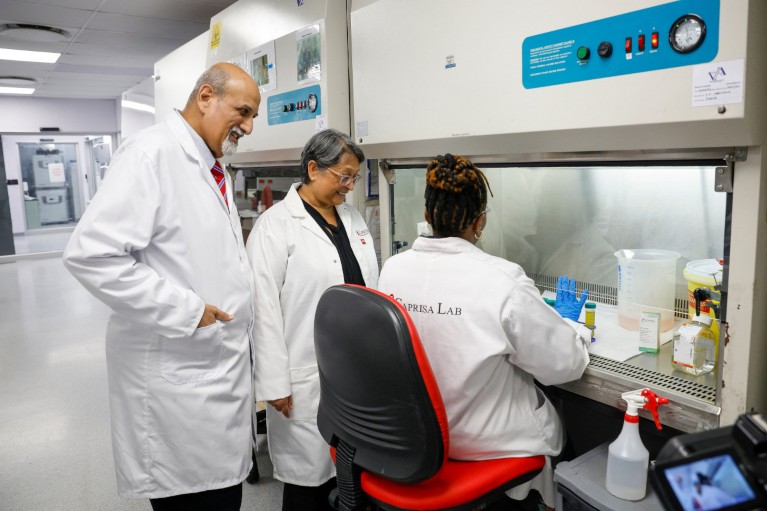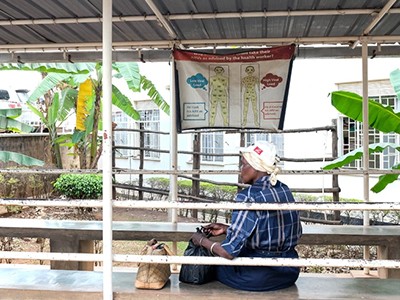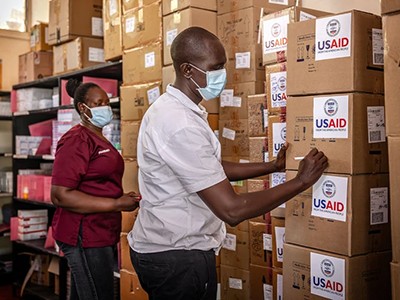
Salim Abdool Karim (left) and Quarraisha Abdool Karim (centre) founded the Centre for the AIDS Programme of Research in South Africa (CAPRISA), which has been hit by US cuts to international aid.Credit: Phill Magakoe/AFP via Getty
Cuts to international aid ordered by Donald Trump have caused many African HIV researchers to fear for the future of long-term research programmes.
In January, as one of his first acts after taking office, the US president froze all foreign aid and announced a 90-day review — scheduled to end today. That move and the firing of all but 15 employees at the US Agency for International Development (USAID) mean the agency has, in effect, been closed down.
Also under threat are US National Institutes of Health (NIH) grants that support HIV research in Africa: cuts have affected funding for HIV-related research in specific populations, and a mechanism that awards grants to international collaborators has been suspended. US dollars have been key in mitigating the scourge of the virus, both through research and by providing lifesaving antiretroviral drugs.
Salim Abdool Karim is co-founder and director of the Centre for the AIDS Programme of Research in South Africa (CAPRISA) at the University of KwaZulu-Natal in Durban. He says three USAID-funded collaborative grants for HIV research and one NIH grant related to tuberculosis have been terminated, totalling US$1.4 million.
The public-health physician, who founded CAPRISA with his wife Quarraisha Abdool Karim, an infectious-disease epidemiologist, says that these funding cancellations will stymie the centre’s research, which prioritizes slowing the number of new HIV infections in young women and reducing deaths from HIV–tuberculosis coinfections in Africa.
The end of AIDS is in sight: don’t abandon PEPFAR now
“All our HIV-vaccine trials, and most of our HIV-treatment trials, will be stopped as these are funded by the NIH,” he says. Although he does not expect the suspended work to result in increased deaths, “it will, however, slow scientific progress on HIV vaccines and treatment”, he adds. He doesn’t think that USAID funding will be restored. “Although it has many great scientists, the United States government is now an unreliable funding partner. We have to mobilize our own resources.”
Requests from Nature’s careers team for a response as to how USAID, the NIH and the Trump administration plan to support long-term HIV research and health initiatives in Africa were unanswered by the time of publication.
Scientific capacity at risk
The axeing of USAID funding has impeded HIV research and the provision of antiretrovirals, and many fear the return of an out-of-control pandemic if other sources of money are cut off — such as the $1 million to $3 million per year that the US Centers for Disease Control has historically provided the Africa Centres for Disease Control and Prevention (Africa CDC) and funding from the NIH.
“If NIH funding is terminated, the impact on HIV research in South Africa will be dire. For my centre alone, US sources of funding account for just over 50% of our budget,” Abdool Karim says. The centre, which has an annual budget of about $15 million, currently receives funding from the South African government, the UK government and the NIH, among other sources. USAID funding had accounted for about 10% of CAPRISA’s annual budget, according to Abdool Karim.
“We are using our reserves to keep the research going, and to pay staff, and we are also looking for alternative donor funding,” says Abdool Karim, noting that those reserves will last for only two months. The centre has five grant applications under review at US government agencies, but Abdool Karim thinks they will all be rejected. So, he’s looking for replacement funding from nine grant applications submitted to UK, European and Japanese government agencies, as well as US and European charitable foundations.
However, he and other HIV researchers face steep odds. Official spending on African health aid from the United States and Europe has dropped by 70% over the past four years. And in February, the UK government announced it would reduce its international aid by about £6.2 billion (US$8.2 billion) by 2027, with African nations not being prioritized as recipients, to increase defence spending.
In Uganda, another country with an established HIV research ecosystem, the USAID funding freeze has affected HIV vaccine research at the Uganda Virus Research Institute (UVRI) in Entebbe, says its director, immunologist Pontiano Kaleebu — although that research is continuing with other funding.
On 11 February, Vincent Bagambe, director of planning and strategic information at the Uganda AIDS Commission in Kampala, requested that the Ugandan Parliament provide 300 billion Ugandan shillings (US$81 million) to ensure access to testing and crucial laboratory supplies and drugs. Without US funding, he cautioned, Uganda’s gains in fighting the HIV epidemic could disappear.
“We are at a critical juncture. Uganda has made significant strides in reducing new infections and AIDS-related deaths, but the sudden cut in funding puts these gains at risk,” he said in a statement to Parliament. “We need an additional 300 billion shillings to ensure uninterrupted access to treatment, laboratory monitoring and other essential services.” More than half of Uganda’s 1.9-trillion-shilling HIV budget is donor-funded, with a significant portion coming from the US President’s Emergency Plan for AIDS Relief (PEPFAR), initiated by former US president George W. Bush. PEPFAR has also been gutted by the Trump administration, which suspended funding and ordered 270,000 global health-care workers to stop caring for patients.
25 million deaths: what could happen if the US ends global health funding
In the past two decades, tremendous progress has been made in Uganda in the fight against AIDS. According to the Uganda AIDS Commission’s annual report for 2023, new HIV infections dropped by 61% and AIDS-related deaths fell by 63% between 2010 and 2022. Adult HIV prevalence fell from around 20% in the early 1990s to 5% in 2022. In 2023, of the estimated 1.5 million people living with HIV in the country, 84% were receiving antiretroviral treatment, and 80% had suppressed viral loads.
In March, Debra Mulongo Barasa, an infectious-disease physician and former Kenyan secretary of health, warned government officials about the impact of the USAID cuts on her country.
In a document entitled ‘Impact of the United States Government Stop Work Order’, she lays out strategies to fill the health funding gaps, such as creating a contingency fund and directing the treasury to immediately release a supplementary budget.
The document also reveals that the US government had been funding 24.9 billion Kenyan shillings (US $191 million), or about 31% of the country’s National Health Program, including some 8.9 billion shillings that that went to HIV-related projects. It warns that lab supplies that are key for antiretroviral therapy could run out by November. The document calls for immediate domestic funding from the treasury, renegotiation with the US government and the creation of programmes to increase the availability of locally manufactured drugs.
Without big influxes of cash to replace the US funding, researchers have estimated that there will be 15 million more global AIDS deaths by 2040, with the majority of them occurring in six African countries, including Mozambique, Nigeria and Uganda.
Last year, the United States spent roughly $12 billion on global health, accounting for about one-quarter of all donated global health funding in poor countries.




